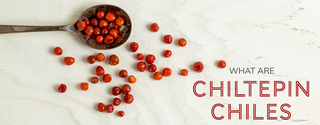What Are Chiltepin Peppers
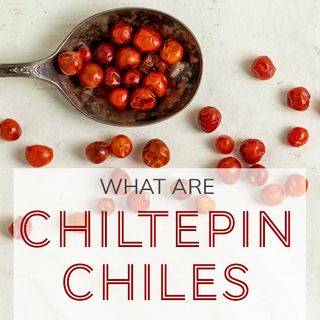
What Are Chiltepin Chiles?
Chiltepin Pepper (pronounced "CHIL-te-pin"), Capsicum annuum, are tiny red chiles, roughly ¼ inch across, that look more like a berry than a pepper. Across the American Southwest, they are commonly found toasted, ground, put into shakers, and kept on the table with the salt and pepper.
Chiltepin chiles pack a punch and are one of our “crazy hot” chiles; these little chiles measure 50,000-100,000 Scoville Heat Units (SHU). Though their ancestor peppers originated in South America, Chiltepins are the only chile indigenous to the United States.
They are also called chile chiltepin, chile tepin, or just chiltepin. In Mexico, these are often called arrebatado, which translates to "violent" or "rapid" and suggests an intense heat that diminishes quickly.
Table of Contents
What Does a Chiltepin Pepper Look Like?
What Does Chiltepin Taste Like?
How Hot Is a Chiltepin Pepper?
What To Do With Chiltepin Pepper
When Did the Chiltepin Pepper Become the Texas State Pepper?
What To Look For When Buying Chiltepin Chiles
All About Chile Chiltepin
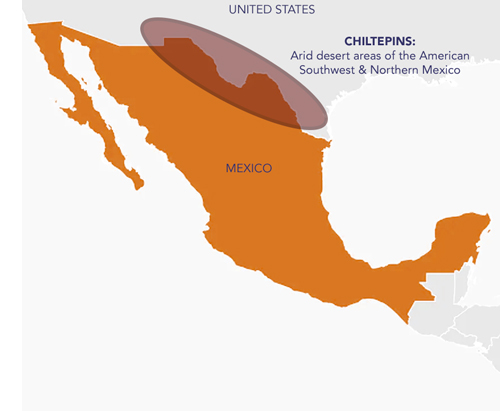 The world chiltepin comes from Nahuatl, the language of the Aztecs. It’s a compound word combining chil-, or “chile pepper”, and -tecpintl, or “flea”. Chiltecpíntl (pronounced chil-TECK-peent) translates to "flea chile" and denotes this pepper’s small size. The word was initially borrowed into Spanish as chiltecpin (pronounced CHIL-teck-peen), which then softened into its current spelling and pronunciation.
The world chiltepin comes from Nahuatl, the language of the Aztecs. It’s a compound word combining chil-, or “chile pepper”, and -tecpintl, or “flea”. Chiltecpíntl (pronounced chil-TECK-peent) translates to "flea chile" and denotes this pepper’s small size. The word was initially borrowed into Spanish as chiltecpin (pronounced CHIL-teck-peen), which then softened into its current spelling and pronunciation.
A study released in 2014 shows the Chiltepin was likely the first domesticated chile pepper in the Central-east Mexico region and the ancestral pepper for modern chiles. Chiltepin remains were found with the remains of domestic maize, squash, and other plants intentionally planted for agricultural use instead of harvested from the wild. The remains suggest chiles were domesticated as early as 7000-9000 BC1.
In honor of their long-reaching legacy, Chiltepins are often referred to as the “mother of all peppers2”, but it has a more recent rich history along the US and Mexico borderlands. It has been used as a food and medicine, and has earned an official designation by the state of Texas.
As you can see, Mexican chiles have a long and storied history, borne out of a single pepper in the wild. With thousands of years of history behind Mexican chiles, it’s easy to see why there’s so much to learn about them. Understanding dried peppers mean understanding the difference between dried and fresh peppers, how drying chiles create a range of flavors in the peppers, and even that one fresh pepper can be processed in different ways and create multiple dried varieties.
Spices, Inc. has been sourcing, processing, and selling Mexican dried chiles since 2008. You can find our Mexican chiles bubbling in the pots of hot sauce crafters, defining the sauces and seasonings in Mexican restaurants, and steeping in kegs in microbreweries and homes across the country.
Over a decade of experience working with dried Mexican peppers has given us ample opportunities to understand chile peppers like the Chiltepin. We want to share this information with you. We can help you determine if their heat level is right for you. You’ll learn how to prepare and cook with them. You’ll discover how and where to shop for Chiltepin peppers, the pros and cons of different markets, and how best to store your Chiltepins so you can have them for a long time.
| Ingredients | Chiltepin chiles |
| Also Called | Chile chiltepin, chile tepin, or just chiltepin |
| Recommended Uses | Use in chili, cream sauces, soft cheese, hot sauce, salsa, or hearty stew |
| Flavor Profile | A distinctive smoky bite with an upfront heat that dissipates quickly |
| Scoville Heat Units | 50,000-100,000 SHU |
| Botanical Name | Capsicum annuum |
| Cuisine | Mexican or southwestern US |
| How To Store | Airtight container in a cool, dark place |
| Shelf Life | 1-2 Years |
| Country of Origin | Mexico or US |
What Does a Chiltepin Pepper Look Like?
Chiltepin chiles look more like a small, round berry than a chile. They are scarlet red and are about ¼ inch across at their widest point.
Is Chile Pequin the Same as Chiltepin?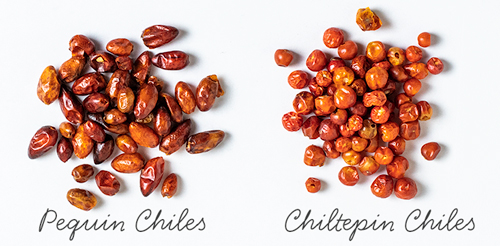
Chile Pequin and Chiltepin are not the same pepper, despite a resemblance to one another and some unfortunate cross-labeling.
Chiltepin was the first chile to be domesticated thousands of years ago. The seeds were dispersed mainly through migratory birds and elements like wind and sea currents, from South America up through Mexico and into the Caribbean islands.
Time and microclimates caused ancestral peppers to adapt to their surroundings so they could thrive in new environments, creating thousands of different types of chiles. Among those is the Pequin.
The Pequin pepper is a close relative of the Chiltepin and is also tiny and a startling shade of red. They are a landrace chile that developed from the Chiltepin, thanks to the influences of climate and pollination, in the Mexican state of Tabasco.
Pequin chiles are small and oval-shaped and taper to a point. Chiltepin chiles are smaller, about half the size of the Pequin, and round like a berry.
Chiltepins have a SHU of 50,000-100,000. They are about twice as hot as the Pequin, which measures 30,000-60,000 SHU.
The flavor of Pequin chiles is fruity and robust, with a heat that comes on slowly and lingers. Chiltepin chiles are earthy, sharp, and mildly smoky.
Chiltepin is occasionally referred to as “chilpequin”, particularly in areas of South Texas. This is a local dialectical quirk and does not mean that Chiltepins and Pequins are the same product.
Both chiles are regularly used to flavor chilis and stews an give an extra boost to traditional salsa. Pequin peppers have a more fruity flavor than Chiltepin, and while they are less spicy than Chiltepin, the flavor lingers. The Pequin’s great taste and long-lasting heat make them a favorite in hot sauces. Chiltepins are hotter, but their heat fades quickly. They are more commonly used as a finishing pepper, sprinkled over a dish right before serving to add a burst of spicy heat.
Why Is Chiltepin So Expensive?
The Chiltepin chile is expensive because it is relatively rare and in reasonably high demand. This chile has never taken well to orderly, commercial farming. It grows on shrubs in canyons and rocky crevasses throughout parts of Arizona, New Mexico, Texas, and northern Mexico. Because it is in hard-to-reach, usually wild spaces, the Chiltepin has to be harvested by hand, which is a long and laborious process.
What Does Chiltepin Taste Like?
Chiltepin chiles are bold and intriguing. They have a distinctive, sharp flavor complemented by hints of earthiness and smokiness. Their heat comes on right away but dissipates quickly.
How Hot Is a Chiltepin Pepper?
Chiltepin peppers measure between 50,000-100,000 Scoville Heat Units (SHU).
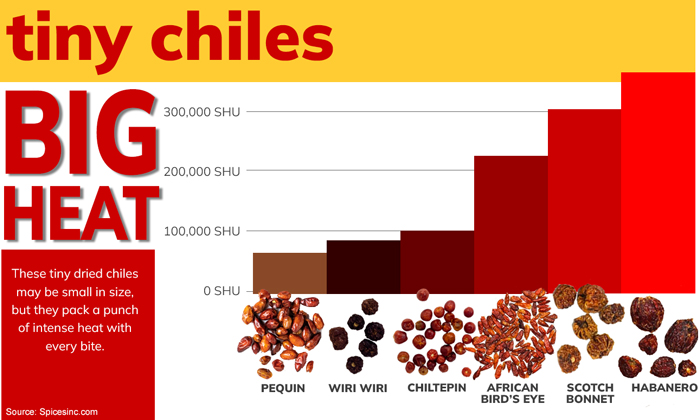
Is a Chiltepin Hotter than a Jalapeno?
Chiltepin chiles have a SHU of 50,000-100,000. Jalapenos measure 2,500-8,000 SHU. This means Chiltepin can be up to 40 times hotter than a milder jalapeno and almost 13 times hotter than the hottest jalapeno.
What To Do With Chiltepin Pepper
Chiltepin peppers are often ground and added to cream sauces and soft cheeses before serving to provide a bold contrast to creamy food. Chiltepins are also fermented by soaking them in a saltwater brine for a few days and then blended into a hot sauce.
Its spicy, bright flavor is home in Mexican recipes. Use early when cooking a pot of hot Texas chili if you want the Chiltepin to infuse the entire pot with flavor, or sprinkle some ground chiles over the top of your finished dish for a burst of bright and smoky heat.
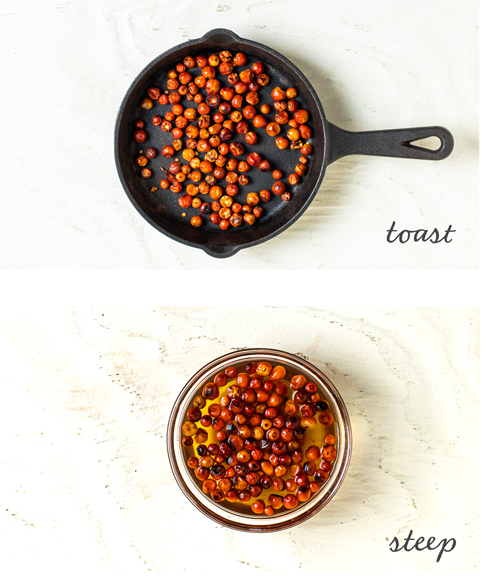 How to Toast
How to Toast
We recommend that you dry-toast your Chiltepin chiles before using them, whether you plan to rehydrate them or turn them into powder. Chiltepins have very thin skin, so it won’t take long to toast them. Put them in a pan that’s been warmed over medium-high heat. Stir them constantly in the pan for 30-45 seconds. The skins will blister, turn a darker shade of red, and begin to smell fruity and woodsy. Remove from heat immediately. If you’re grinding them, let them cool until you can handle them. If you’re rehydrating them, you can immediately move on to the next step.
How To Deseed
We don’t feel deseeding is necessary for this chile; instead, we think the small number of seeds in the Chiltepin contributes to its overall flavor.
How To Rehydrate
To rehydrate your Chiltepins, pour boiling water over the peppers. Let them sit in hot water for 10 minutes. Drain the water. Your chiles are ready to mix into a paste or blend into a puree.
The Chiltepin water will be sweet but highly spicy. It can be used sparingly to thin out hot sauces. It can be stored in your refrigerator for up to two weeks.
How to Make Chiltepin Powder
Once Chiltepins are toasted and are cool enough to handle, put them in an electric spice grinder or mortar and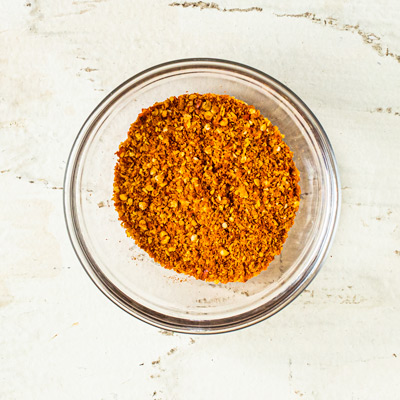 pestle. Grind to desired consistency. Use right away or store in an airtight container for future use.
pestle. Grind to desired consistency. Use right away or store in an airtight container for future use.
How to Store
If stored properly, Chiltepin peppers will remain viable for 1-2 years. They should be kept in an opaque plastic or glass jar with an airtight seal. They should be protected from moisture, heat, and direct sunlight, which can raise the temperature in a jar and compromise the integrity of the chile. Never store your chiles in the bags they are shipped in for extended periods.
To guard against the effects of ambient heat, store your peppers far away from your stove and oven. When you use the oven or store, the air temperature around them rises. This can cause chiles stored near the stove to start to sweat. Though technically dry, they retain about 10% of their original moisture locked in their cells. That moisture will lay on the dried chiles in an airtight container with no way for sweat to evaporate. It can quickly lead to mold and mildew on the peppers.
Chiltepins look dry and feel delicate because of their thin skins. They smell a bit smoky and fruity, with even a hint of citrus at the top of the aroma. There will likely be some breakage in their storage container, but they should be, for the most part, intact.
How Long Will They Last?
In a controlled environment, Chiltepin chiles can have an extended shelf life of 2-3 years. They would need to be in a pantry with a temperature that will not go below 60°F or above 72°F and where humidity can be kept to a minimum. In a home environment, chiles should be kept in jars, never bags, and the jars should be glass or plastic, opaque, and away from direct sunlight. We don’t feel these conditions are attainable for most chile storage, so we recommend that you expect a standard 1-2 year span for your peppers.
Can You Freeze Chiltepin?
You can freeze Chiltepin chiles. Double-bag them in sturdy freezer bags and put them right in the freezer. Chiles should be stored in small packages—what you think you would need to make a batch of salsa or to use to cook your favorite dishes. Take out the small packages as needed and leave them on the counter to thaw.
Due to the freezing process, your thawed chiles will probably be softer than they are when fresh. Do not use them as a “fresh” chile since the texture will not be correct. Only use them in recipes that require them to be cooked.
We don’t recommend keeping them in the freezer for longer than one year. If they are in the freezer longer, they may succumb to freezer burn.
When Did the Chiltepin Pepper Become the Texas State Pepper?
The Chiltepin pepper is not the Texas State Pepper but the Texas State Native Pepper. It was given that designation in 1997, recognizing that it is the only pepper native to the United States.
The jalapeno was designated as the official Texas State Pepper in 1995.

Chiltepin Pepper Substitute
To approximate the heat level on the Chiltepin Peppers (50,000-100,000 SHU), your best bet as a substitute would be its close relative, the Pequin chile. The Pequin is about half as hot, with a Scoville Heat measurement of 30,000-60,000 SHU. Thai Bird Chiles, 70,000 – 130,000 SHU, are hotter than Chiltepins but also have a bold flavor and bright heat.
What To Look For When Buying Chiltepin Chiles
Chiltepin peppers should be plump and berry-like. They have a bright, tomato-red color, with some wrinkling and dimpling from dehydration. Their skins are thin, so there may be some breakage when buying them, but you should look for mostly intact ones. They have a terrific, slightly smoky, nutty aroma, with hints of fruit on the top notes.
Where to Buy Chiltepin Peppers
Chiltepin chiles are primarily known in the American Southwest, where they grow wild in their preferred habitats. They can still be found in Mexican markets, some grocery stores, and big-box and online specialty retailers. These shopping environments offer various positives and negatives.
In a Mexican market, you’re likely to encounter employees who are comfortable with chiles and how to use them. They are great resources if you’ve got questions, so you can feel confident that you’re getting the pepper that suits your needs.
Markets like this are often small, though. They don’t have as much traffic as other retail environments, so their stock doesn’t move as quickly. This means chiles will spend more of their viable shelf life in the store, cutting down on time in your pantry. These stores cannot also negotiate for lower wholesale prices, and the higher cost to stock the store gets passed on to consumers.
Larger chain grocery stores have negotiating power when buying bulk from their wholesalers. The lower bulk pricing means they can charge their customers less and still maintain a profit. These stores center their purchasing on the most popular chiles for bulk pricing, which can be shipped to multiple stores in the chain. This means their overall selection is limited. Unless you live in the southwestern U.S., you are unlikely to find Chiltepin peppers at the local grocery store.
If you’re shopping online, it’s tempting to go to the big-box vendors. They seem to have access to harder-to-find products, the benefits of one-stop shopping, and perks like free and fast shipping. However, these giant retailers often serve as fulfillment centers for third-party vendors, so there is no chile-specific oversight or training at the point of sale to guarantee the quality or accuracy of orders.
Online specialty vendors usually build their business on product knowledge and selection. These independent retailers have earned their reputation through employee education; employees from customer service to order fulfillment know the differences between chiles and can identify a Chiltepin vs. a Pequin pepper.
Specialty vendors have developed practices for selecting and packing chiles promptly and accurately. Combined with the emphasis on product knowledge, these vendors offer expertise and timely service, and customers can feel confident that they will get the peppers they’ve ordered.
Chiltepin chiles, the Mother of All Chiles, are bright, spicy little flavor bombs. They create a natural contrast for creamy dishes, and a robust base for salsa, with their sweeping, up-front heat. Once the heat fades, you can taste their rich and earthy flavor, so they deliver on many levels.
The chiles of Mexico have been adopted into the cuisines worldwide thanks to their enormous range of flavors and heat levels. They can be used whole, ground, or soaked and pureed to create a wealth of dishes, and you can find just about any flavor profile you need. Mexican chiles took over the culinary world because of their infinite adaptability, but the Chiltepin is the pepper that started it all.
References
1. Kraft, K. H., Brown, C. H., Nabhan, G. P., Luedeling, E., Luna Ruiz, J. D. J., Coppens d’Eeckenbrugge, G., Hijmans, R. J., & Gepts, P. (2014). Multiple lines of evidence for the origin of domesticated chili pepper, Capsicum annuum, in Mexico. Proceedings of the National Academy of Sciences, 111(17), 6165–6170.
2. Pack, M. M. (2011, August 26). Chiltepins: The mother of all peppers. The Austin Chronicle. Retrieved July 27, 2022.

